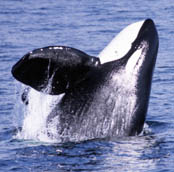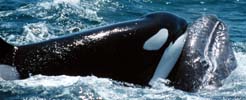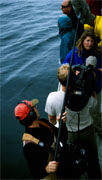|
 |
|
The Blue Planet: Seas of Life, an eight-part series and a
co-production between the Discovery Channel and the BBC, aired January
27 and 28 from 9 to 11 p.m, with the final parts airing on May 5.
The first part, "Ocean World", contained one of the most spectacular
wildlife events ever filmed. If you missed the show on January 27th,
the first part, "Ocean World", will also be airing on:
Sunday, May 5 at 3 p.m.
Wednesday, May 29 at 8 p.m.
Wednesday, May 29 at 11 p.m.
|
Nancy Black, owner of Monterey Bay Whale Watch, was the scientist
on the film project.
| The "Ocean World" episode airing on Jan. 27 includes a feature
on the predation of Killer Whales in Monterey Bay. With assistance
from biologist Nancy Black and Richard Ternullo of Monterey
Bay Whale Watch, Doug Allan -- one of the BBC's top filmmakers
-- along with Tom Fitz filmed for the first time a pod of Killer
Whales attacking a Gray Whale in Monterey Bay. |
|

Click to see larger photo |
For two months in 1998 and 1999, the BBC crew worked in Monterey Bay
with Killer Whale researchers Nancy Black and Richard Ternullo. As
the leading authorities on Killer Whales off the California coast
and especially Monterey Bay, Nancy and Richard guided the film crew
and maneuvered the boat during their research season in hopes of finding
Killer Whales pursuing Gray Whales. The researchers have all the Killer
Whales individually identified by their natural markings and have
had repeated sightings of the same groups over the last 15 years.
After just three days of searching the Bay for this unpredictable
predation event, the team came across two adult male Killer Whales
in pursuit of a mother and calf Gray Whale. "It was an incredible
sight to see the two males leaping after the Grays in perfect synchrony.
After a short pursuit the two males worked as a team to block the
Gray Whales' movement. They showed awesome power as the males repeatedly
bashed into and body slammed the calf," said Nancy. These two males
possibly are related and have been sighted together for several years.
Killer Whales are the top predators of the ocean and the only natural
predator of the Gray Whale. These events have been occurring for thousands
of years and only recently have been filmed and studied.
Just after this first event, the team was alerted to another group
of twelve Killer Whales, composed of mostly adult females with their
juveniles and calves. This group also had been pursuing a mother and
calf Gray Whale. The mother Gray doesn't have many defenses against
the Killer Whales who are just after her calf. The mother often rolled
belly up and attempted to keep her calf on her belly and out of the
water. But the Killer Whales were intent on pursuing the calf and
one adult female Killer Whale positioned herself in a dangerous area
between the mother Gray and calf in an attempt to separate the calf.
While this female stayed in-between, several other adult females rammed
the calf and grabbed onto its flippers.
Nancy commented, "During this attack, the calf showed amazing resilience
in its fight for life, and the terror in the eye of the calf was heartwrenching,
but the Killer Whales also had several calves with them and they were
learning to hunt and feed on this very important food source, not
unlike wolves or lions hunting their prey." Eventually one female
Killer Whale got on top of the exhausted and injured calf to finally
drown it. The Killer Whales then began the long process of feeding
on the whale, mostly taking the tongue and some blubber. The group
of 14 Killer Whales were still feeding the next morning then left
the carcass and headed out along the edge of the Monterey submarine
canyon. Within two hours they had located another pair of Gray Whales
and began another attack but this time the mother and calf got away
and the Killer Whales moved on.
Killer Whales are highly intelligent and social mammals and their
young often stay with their mothers and other closely related individuals
for life. Hunting Gray Whales takes tremendous skill and communication
among Killer Whales. These transient type Killer Whales periodically
travel through Monterey Bay and range from southern California to
Alaska, preying on seals, seal lions, dolphins, porpoise, and whales.
Nancy and Richard have identified over 100 different transients in
Monterey Bay that travel in groups of 2 to 25 individuals, with an
average of 1 to 7 sightings per month. This is an ongoing project
and this long-term study with well-known whales and their calves is
beginning to solve some of the mysteries of one of nature's most majestic
mammals.
 Visit
our Photo Gallery for an incredible
sequence of photographs taken during these attacks. Visit
our Photo Gallery for an incredible
sequence of photographs taken during these attacks. |
To get more information on the total Blue Planet: Seas of Life
Series go to The
Blue Planet on the BBC website.
On the BBC website the first part of the series is referred to as the
"Introduction," but on the Discovery Channel website the first part is
named "Ocean World."
To find dates and times of the Discovery Channel broadcasts of Blue
Planet: Seas of Life go to the Blue
Planet: Seas of Life page on the Discovery Channel website.
 |
|
The Blue Planet: Seas of Life aired in Europe last fall.
People who have seen the show in Europe and are participating in Monterey
Bay Whale Watch trips often recognize Nancy Black, who was the scientist
on the project filming the Killer Whale predation in Monterey Bay,
and appeared in the behind-the-scenes portion of a later episode.
We hope you had an opportunity to see the show on January 27, or will
be able to watch one of the reruns listed above. The whole series
will be well worth watching. It took 5 years to make this series which
consists of eight parts total. Four parts air this month:
January 27th: "Ocean World" and "Frozen
Seas"
January 28th: "Open Ocean" and "The
Deep"
The final four episodes will air in May. |
The series as described by the Discovery Channel:
"Sail the seas from reef to pole and shore to abyss to discover unknown
creatures, uncharted depths and unimaginable dramas. Shot in more than
200 locations over five years, this series offers the definitive story
of the ocean, revealing all its power, beauty and mystery."
Enjoy the show!
|
|
![]()
![]()
